


2019 3 IV Sedan
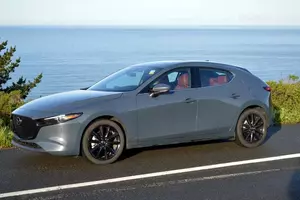
2019 3 IV Hatchback

2017 3 III Sedan (BM, facelift 2017)
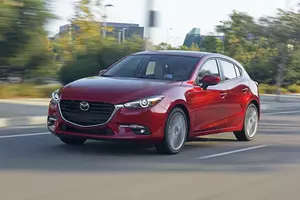
2017 3 III Hatchback (BM, facelift 2017)
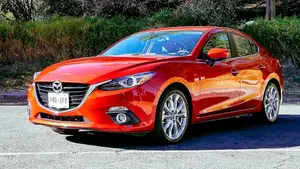
2014 3 III Sedan (BM)

2013 3 III Hatchback (BM)

2011 3 II Hatchback (BL, facelift 2011)

2011 3 II Sedan (BL, facelift 2011)
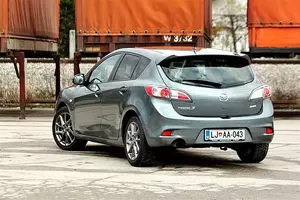
2012 3 TAKUMI
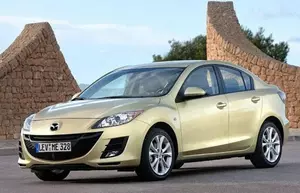
2009 3 II Sedan (BL)
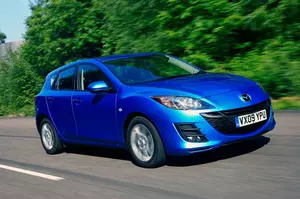
2009 3 II Hatchback (BL)
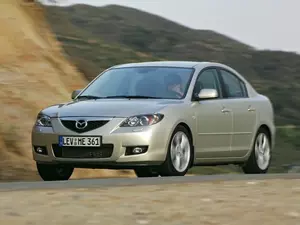
2006 3 I Sedan (BK, facelift 2006)

2006 3 I Hatchback (BK, facelift 2006)
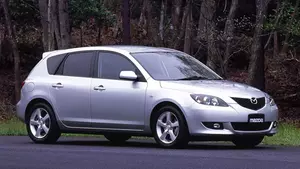
2004 3 I Hatchback (BK)
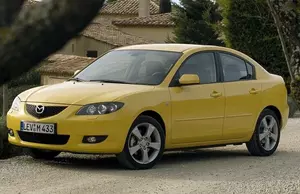
2004 3 I Sedan (BK)

| Vehicle | Precise engine size | Difference from world average | Engine size to consumption ratio | Horsepower from 1 L | Engine size to 100 kg of weight |
|---|---|---|---|---|---|
| 2.0 SkyActiv-G |
2 L (1998 cc) |
14.8% smaller | 46 cc to 1 mpg | 61 hp from 1 L | 143 cc to 100 kg |
| 2.0 SkyActiv-X |
2 L (1998 cc) |
14.8% smaller | - | 91 hp from 1 L | 143 cc to 100 kg |
| 1.8 SkyActiv-D |
1.76 L (1759 cc) |
25% smaller | 31 cc to 1 mpg | 66 hp from 1 L | 126 cc to 100 kg |
| 2.5 SkyActiv-G |
2.49 L (2488 cc) |
6.1% bigger | - | 75 hp from 1 L | - |
| 1.5 SKYACTIV-G |
1.5 L (1496 cc) |
36.2% smaller | - | 79 hp from 1 L | 107 cc to 100 kg |
| 2.0 SKYACTIV-G |
2 L (1998 cc) |
14.8% smaller | - | 81 hp from 1 L | 143 cc to 100 kg |
| Vehicle | 2.0 SkyActiv-G |
|---|---|
| Precise engine size | 2 L (1998 cc) |
| Difference from world average | 14.8 smaller |
| Engine size to consumption ratio | 46 cc to 1 mpg |
| Horsepower from 1 L | 61 hp from 1 L |
| Engine size to 100 kg of weight | 143 cc to 100 kg |
| Vehicle | 2.0 SkyActiv-X |
| Precise engine size | 2 L (1998 cc) |
| Difference from world average | 14.8 smaller |
| Engine size to consumption ratio | - |
| Horsepower from 1 L | 91 hp from 1 L |
| Engine size to 100 kg of weight | 143 cc to 100 kg |
| Vehicle | 1.8 SkyActiv-D |
| Precise engine size | 1.76 L (1759 cc) |
| Difference from world average | 25 smaller |
| Engine size to consumption ratio | 31 cc to 1 mpg |
| Horsepower from 1 L | 66 hp from 1 L |
| Engine size to 100 kg of weight | 126 cc to 100 kg |
| Vehicle | 2.5 SkyActiv-G |
| Precise engine size | 2.49 L (2488 cc) |
| Difference from world average | 6.1 bigger |
| Engine size to consumption ratio | - |
| Horsepower from 1 L | 75 hp from 1 L |
| Engine size to 100 kg of weight | - |
| Vehicle | 1.5 SKYACTIV-G |
| Precise engine size | 1.5 L (1496 cc) |
| Difference from world average | 36.2 smaller |
| Engine size to consumption ratio | - |
| Horsepower from 1 L | 79 hp from 1 L |
| Engine size to 100 kg of weight | 107 cc to 100 kg |
| Vehicle | 2.0 SKYACTIV-G |
| Precise engine size | 2 L (1998 cc) |
| Difference from world average | 14.8 smaller |
| Engine size to consumption ratio | - |
| Horsepower from 1 L | 81 hp from 1 L |
| Engine size to 100 kg of weight | 143 cc to 100 kg |

| Vehicle | Precise engine size | Difference from world average | Engine size to consumption ratio | Horsepower from 1 L | Engine size to 100 kg of weight |
|---|---|---|---|---|---|
| 2.0 SkyActiv-G |
2 L (1998 cc) |
14.8% smaller | 46 cc to 1 mpg | 61 hp from 1 L | 143 cc to 100 kg |
| 2.0 SkyActiv-X |
2 L (1998 cc) |
14.8% smaller | - | 91 hp from 1 L | 133 cc to 100 kg |
| 1.8 SkyActiv-D |
1.76 L (1759 cc) |
25% smaller | 35 cc to 1 mpg | 66 hp from 1 L | 126 cc to 100 kg |
| 1.5 SKYACTIV-G |
1.5 L (1496 cc) |
36.2% smaller | - | 79 hp from 1 L | 107 cc to 100 kg |
| 2.0 SKYACTIV-G |
2 L (1998 cc) |
14.8% smaller | - | 81 hp from 1 L | 143 cc to 100 kg |
| 2.5 SkyActiv-G |
2.49 L (2488 cc) |
6.1% bigger | - | 75 hp from 1 L | - |
| Vehicle | 2.0 SkyActiv-G |
|---|---|
| Precise engine size | 2 L (1998 cc) |
| Difference from world average | 14.8 smaller |
| Engine size to consumption ratio | 46 cc to 1 mpg |
| Horsepower from 1 L | 61 hp from 1 L |
| Engine size to 100 kg of weight | 143 cc to 100 kg |
| Vehicle | 2.0 SkyActiv-X |
| Precise engine size | 2 L (1998 cc) |
| Difference from world average | 14.8 smaller |
| Engine size to consumption ratio | - |
| Horsepower from 1 L | 91 hp from 1 L |
| Engine size to 100 kg of weight | 133 cc to 100 kg |
| Vehicle | 1.8 SkyActiv-D |
| Precise engine size | 1.76 L (1759 cc) |
| Difference from world average | 25 smaller |
| Engine size to consumption ratio | 35 cc to 1 mpg |
| Horsepower from 1 L | 66 hp from 1 L |
| Engine size to 100 kg of weight | 126 cc to 100 kg |
| Vehicle | 1.5 SKYACTIV-G |
| Precise engine size | 1.5 L (1496 cc) |
| Difference from world average | 36.2 smaller |
| Engine size to consumption ratio | - |
| Horsepower from 1 L | 79 hp from 1 L |
| Engine size to 100 kg of weight | 107 cc to 100 kg |
| Vehicle | 2.0 SKYACTIV-G |
| Precise engine size | 2 L (1998 cc) |
| Difference from world average | 14.8 smaller |
| Engine size to consumption ratio | - |
| Horsepower from 1 L | 81 hp from 1 L |
| Engine size to 100 kg of weight | 143 cc to 100 kg |
| Vehicle | 2.5 SkyActiv-G |
| Precise engine size | 2.49 L (2488 cc) |
| Difference from world average | 6.1 bigger |
| Engine size to consumption ratio | - |
| Horsepower from 1 L | 75 hp from 1 L |
| Engine size to 100 kg of weight | - |

| Vehicle | Precise engine size | Difference from world average | Engine size to consumption ratio | Horsepower from 1 L | Engine size to 100 kg of weight |
|---|---|---|---|---|---|
| 2.0 SkyActiv-G |
2 L (1998 cc) |
14.8% smaller | 64 cc to 1 mpg | 78 hp from 1 L | 154 cc to 100 kg |
| 1.5 SkyActiv-D |
1.5 L (1499 cc) |
36.1% smaller | 24 cc to 1 mpg | 70 hp from 1 L | 115 cc to 100 kg |
| 2.2 SkyActiv-D |
2.19 L (2191 cc) |
6.6% smaller | 37 cc to 1 mpg | 68 hp from 1 L | 169 cc to 100 kg |
| 2.5 SkyActiv-G |
2.49 L (2488 cc) |
6.1% bigger | 83 cc to 1 mpg | 74 hp from 1 L | 178 cc to 100 kg |
| Vehicle | 2.0 SkyActiv-G |
|---|---|
| Precise engine size | 2 L (1998 cc) |
| Difference from world average | 14.8 smaller |
| Engine size to consumption ratio | 64 cc to 1 mpg |
| Horsepower from 1 L | 78 hp from 1 L |
| Engine size to 100 kg of weight | 154 cc to 100 kg |
| Vehicle | 1.5 SkyActiv-D |
| Precise engine size | 1.5 L (1499 cc) |
| Difference from world average | 36.1 smaller |
| Engine size to consumption ratio | 24 cc to 1 mpg |
| Horsepower from 1 L | 70 hp from 1 L |
| Engine size to 100 kg of weight | 115 cc to 100 kg |
| Vehicle | 2.2 SkyActiv-D |
| Precise engine size | 2.19 L (2191 cc) |
| Difference from world average | 6.6 smaller |
| Engine size to consumption ratio | 37 cc to 1 mpg |
| Horsepower from 1 L | 68 hp from 1 L |
| Engine size to 100 kg of weight | 169 cc to 100 kg |
| Vehicle | 2.5 SkyActiv-G |
| Precise engine size | 2.49 L (2488 cc) |
| Difference from world average | 6.1 bigger |
| Engine size to consumption ratio | 83 cc to 1 mpg |
| Horsepower from 1 L | 74 hp from 1 L |
| Engine size to 100 kg of weight | 178 cc to 100 kg |

| Vehicle | Precise engine size | Difference from world average | Engine size to consumption ratio | Horsepower from 1 L | Engine size to 100 kg of weight |
|---|---|---|---|---|---|
| 2.0 SkyActiv-G |
2 L (1998 cc) |
14.8% smaller | 64 cc to 1 mpg | 78 hp from 1 L | 154 cc to 100 kg |
| 1.5 SkyActiv-G |
1.5 L (1496 cc) |
36.2% smaller | 33 cc to 1 mpg | 67 hp from 1 L | 125 cc to 100 kg |
| 2.2 SkyActiv-D |
2.19 L (2191 cc) |
6.6% smaller | 45 cc to 1 mpg | 68 hp from 1 L | 169 cc to 100 kg |
| 1.5 SkyActiv-D |
1.5 L (1499 cc) |
36.1% smaller | 28 cc to 1 mpg | 70 hp from 1 L | 115 cc to 100 kg |
| 2.5 SkyActiv-G |
2.49 L (2488 cc) |
6.1% bigger | 89 cc to 1 mpg | 74 hp from 1 L | 178 cc to 100 kg |
| Vehicle | 2.0 SkyActiv-G |
|---|---|
| Precise engine size | 2 L (1998 cc) |
| Difference from world average | 14.8 smaller |
| Engine size to consumption ratio | 64 cc to 1 mpg |
| Horsepower from 1 L | 78 hp from 1 L |
| Engine size to 100 kg of weight | 154 cc to 100 kg |
| Vehicle | 1.5 SkyActiv-G |
| Precise engine size | 1.5 L (1496 cc) |
| Difference from world average | 36.2 smaller |
| Engine size to consumption ratio | 33 cc to 1 mpg |
| Horsepower from 1 L | 67 hp from 1 L |
| Engine size to 100 kg of weight | 125 cc to 100 kg |
| Vehicle | 2.2 SkyActiv-D |
| Precise engine size | 2.19 L (2191 cc) |
| Difference from world average | 6.6 smaller |
| Engine size to consumption ratio | 45 cc to 1 mpg |
| Horsepower from 1 L | 68 hp from 1 L |
| Engine size to 100 kg of weight | 169 cc to 100 kg |
| Vehicle | 1.5 SkyActiv-D |
| Precise engine size | 1.5 L (1499 cc) |
| Difference from world average | 36.1 smaller |
| Engine size to consumption ratio | 28 cc to 1 mpg |
| Horsepower from 1 L | 70 hp from 1 L |
| Engine size to 100 kg of weight | 115 cc to 100 kg |
| Vehicle | 2.5 SkyActiv-G |
| Precise engine size | 2.49 L (2488 cc) |
| Difference from world average | 6.1 bigger |
| Engine size to consumption ratio | 89 cc to 1 mpg |
| Horsepower from 1 L | 74 hp from 1 L |
| Engine size to 100 kg of weight | 178 cc to 100 kg |

| Vehicle | Precise engine size | Difference from world average | Engine size to consumption ratio | Horsepower from 1 L | Engine size to 100 kg of weight |
|---|---|---|---|---|---|
| 2.0 SkyActiv-G |
2 L (1998 cc) |
14.8% smaller | 48 cc to 1 mpg | 60 hp from 1 L | 167 cc to 100 kg |
| 1.5 SkyActiv-G |
1.5 L (1496 cc) |
36.2% smaller | 32 cc to 1 mpg | 67 hp from 1 L | 125 cc to 100 kg |
| 2.0 Skyactiv-G |
2 L (1998 cc) |
14.8% smaller | 49 cc to 1 mpg | 83 hp from 1 L | 167 cc to 100 kg |
| 2.2 SkyActiv-D |
2.19 L (2191 cc) |
6.6% smaller | 45 cc to 1 mpg | 68 hp from 1 L | 169 cc to 100 kg |
| 1.5 Skyactiv-D |
1.5 L (1498 cc) |
36.1% smaller | 28 cc to 1 mpg | 70 hp from 1 L | 115 cc to 100 kg |
| Vehicle | 2.0 SkyActiv-G |
|---|---|
| Precise engine size | 2 L (1998 cc) |
| Difference from world average | 14.8 smaller |
| Engine size to consumption ratio | 48 cc to 1 mpg |
| Horsepower from 1 L | 60 hp from 1 L |
| Engine size to 100 kg of weight | 167 cc to 100 kg |
| Vehicle | 1.5 SkyActiv-G |
| Precise engine size | 1.5 L (1496 cc) |
| Difference from world average | 36.2 smaller |
| Engine size to consumption ratio | 32 cc to 1 mpg |
| Horsepower from 1 L | 67 hp from 1 L |
| Engine size to 100 kg of weight | 125 cc to 100 kg |
| Vehicle | 2.0 Skyactiv-G |
| Precise engine size | 2 L (1998 cc) |
| Difference from world average | 14.8 smaller |
| Engine size to consumption ratio | 49 cc to 1 mpg |
| Horsepower from 1 L | 83 hp from 1 L |
| Engine size to 100 kg of weight | 167 cc to 100 kg |
| Vehicle | 2.2 SkyActiv-D |
| Precise engine size | 2.19 L (2191 cc) |
| Difference from world average | 6.6 smaller |
| Engine size to consumption ratio | 45 cc to 1 mpg |
| Horsepower from 1 L | 68 hp from 1 L |
| Engine size to 100 kg of weight | 169 cc to 100 kg |
| Vehicle | 1.5 Skyactiv-D |
| Precise engine size | 1.5 L (1498 cc) |
| Difference from world average | 36.1 smaller |
| Engine size to consumption ratio | 28 cc to 1 mpg |
| Horsepower from 1 L | 70 hp from 1 L |
| Engine size to 100 kg of weight | 115 cc to 100 kg |

| Vehicle | Precise engine size | Difference from world average | Engine size to consumption ratio | Horsepower from 1 L | Engine size to 100 kg of weight |
|---|---|---|---|---|---|
| 1.5 SkyActiv-G |
1.5 L (1496 cc) |
36.2% smaller | 33 cc to 1 mpg | 67 hp from 1 L | 125 cc to 100 kg |
| 2.0 SkyActiv-G |
2 L (1998 cc) |
14.8% smaller | 49 cc to 1 mpg | 83 hp from 1 L | 167 cc to 100 kg |
| 2.2 SkyActiv-D |
2.19 L (2191 cc) |
6.6% smaller | 45 cc to 1 mpg | 68 hp from 1 L | 169 cc to 100 kg |
| 1.5 Skyactiv-D |
1.5 L (1498 cc) |
36.1% smaller | 28 cc to 1 mpg | 70 hp from 1 L | 115 cc to 100 kg |
| Vehicle | 1.5 SkyActiv-G |
|---|---|
| Precise engine size | 1.5 L (1496 cc) |
| Difference from world average | 36.2 smaller |
| Engine size to consumption ratio | 33 cc to 1 mpg |
| Horsepower from 1 L | 67 hp from 1 L |
| Engine size to 100 kg of weight | 125 cc to 100 kg |
| Vehicle | 2.0 SkyActiv-G |
| Precise engine size | 2 L (1998 cc) |
| Difference from world average | 14.8 smaller |
| Engine size to consumption ratio | 49 cc to 1 mpg |
| Horsepower from 1 L | 83 hp from 1 L |
| Engine size to 100 kg of weight | 167 cc to 100 kg |
| Vehicle | 2.2 SkyActiv-D |
| Precise engine size | 2.19 L (2191 cc) |
| Difference from world average | 6.6 smaller |
| Engine size to consumption ratio | 45 cc to 1 mpg |
| Horsepower from 1 L | 68 hp from 1 L |
| Engine size to 100 kg of weight | 169 cc to 100 kg |
| Vehicle | 1.5 Skyactiv-D |
| Precise engine size | 1.5 L (1498 cc) |
| Difference from world average | 36.1 smaller |
| Engine size to consumption ratio | 28 cc to 1 mpg |
| Horsepower from 1 L | 70 hp from 1 L |
| Engine size to 100 kg of weight | 115 cc to 100 kg |

| Vehicle | Precise engine size | Difference from world average | Engine size to consumption ratio | Horsepower from 1 L | Engine size to 100 kg of weight |
|---|---|---|---|---|---|
| MPS 2.3i |
2.26 L (2261 cc) |
3.6% smaller | 94 cc to 1 mpg | 115 hp from 1 L | 162 cc to 100 kg |
| 1.6i |
1.6 L (1598 cc) |
31.9% smaller | 43 cc to 1 mpg | 66 hp from 1 L | 133 cc to 100 kg |
| 2.0 CD |
2.18 L (2184 cc) |
6.9% smaller | 49 cc to 1 mpg | 69 hp from 1 L | 156 cc to 100 kg |
| 2.0 DISI |
2 L (1999 cc) |
14.8% smaller | 57 cc to 1 mpg | 75 hp from 1 L | 154 cc to 100 kg |
| 2.0i |
2 L (1999 cc) |
14.8% smaller | 64 cc to 1 mpg | 75 hp from 1 L | 154 cc to 100 kg |
| 2.2 CD |
2.18 L (2184 cc) |
6.9% smaller | 50 cc to 1 mpg | 85 hp from 1 L | 156 cc to 100 kg |
| 1.6 CD |
1.56 L (1560 cc) |
33.5% smaller | 28 cc to 1 mpg | 74 hp from 1 L | 120 cc to 100 kg |
| Vehicle | MPS 2.3i |
|---|---|
| Precise engine size | 2.26 L (2261 cc) |
| Difference from world average | 3.6 smaller |
| Engine size to consumption ratio | 94 cc to 1 mpg |
| Horsepower from 1 L | 115 hp from 1 L |
| Engine size to 100 kg of weight | 162 cc to 100 kg |
| Vehicle | 1.6i |
| Precise engine size | 1.6 L (1598 cc) |
| Difference from world average | 31.9 smaller |
| Engine size to consumption ratio | 43 cc to 1 mpg |
| Horsepower from 1 L | 66 hp from 1 L |
| Engine size to 100 kg of weight | 133 cc to 100 kg |
| Vehicle | 2.0 CD |
| Precise engine size | 2.18 L (2184 cc) |
| Difference from world average | 6.9 smaller |
| Engine size to consumption ratio | 49 cc to 1 mpg |
| Horsepower from 1 L | 69 hp from 1 L |
| Engine size to 100 kg of weight | 156 cc to 100 kg |
| Vehicle | 2.0 DISI |
| Precise engine size | 2 L (1999 cc) |
| Difference from world average | 14.8 smaller |
| Engine size to consumption ratio | 57 cc to 1 mpg |
| Horsepower from 1 L | 75 hp from 1 L |
| Engine size to 100 kg of weight | 154 cc to 100 kg |
| Vehicle | 2.0i |
| Precise engine size | 2 L (1999 cc) |
| Difference from world average | 14.8 smaller |
| Engine size to consumption ratio | 64 cc to 1 mpg |
| Horsepower from 1 L | 75 hp from 1 L |
| Engine size to 100 kg of weight | 154 cc to 100 kg |
| Vehicle | 2.2 CD |
| Precise engine size | 2.18 L (2184 cc) |
| Difference from world average | 6.9 smaller |
| Engine size to consumption ratio | 50 cc to 1 mpg |
| Horsepower from 1 L | 85 hp from 1 L |
| Engine size to 100 kg of weight | 156 cc to 100 kg |
| Vehicle | 1.6 CD |
| Precise engine size | 1.56 L (1560 cc) |
| Difference from world average | 33.5 smaller |
| Engine size to consumption ratio | 28 cc to 1 mpg |
| Horsepower from 1 L | 74 hp from 1 L |
| Engine size to 100 kg of weight | 120 cc to 100 kg |

| Vehicle | Precise engine size | Difference from world average | Engine size to consumption ratio | Horsepower from 1 L | Engine size to 100 kg of weight |
|---|---|---|---|---|---|
| 1.6i |
1.6 L (1598 cc) |
31.9% smaller | 43 cc to 1 mpg | 66 hp from 1 L | 133 cc to 100 kg |
| 2.0 DISI |
2 L (1999 cc) |
14.8% smaller | 57 cc to 1 mpg | 75 hp from 1 L | 154 cc to 100 kg |
| 2.0i |
2 L (1999 cc) |
14.8% smaller | 64 cc to 1 mpg | 75 hp from 1 L | 154 cc to 100 kg |
| 1.6 CD |
1.56 L (1560 cc) |
33.5% smaller | 28 cc to 1 mpg | 74 hp from 1 L | 130 cc to 100 kg |
| Vehicle | 1.6i |
|---|---|
| Precise engine size | 1.6 L (1598 cc) |
| Difference from world average | 31.9 smaller |
| Engine size to consumption ratio | 43 cc to 1 mpg |
| Horsepower from 1 L | 66 hp from 1 L |
| Engine size to 100 kg of weight | 133 cc to 100 kg |
| Vehicle | 2.0 DISI |
| Precise engine size | 2 L (1999 cc) |
| Difference from world average | 14.8 smaller |
| Engine size to consumption ratio | 57 cc to 1 mpg |
| Horsepower from 1 L | 75 hp from 1 L |
| Engine size to 100 kg of weight | 154 cc to 100 kg |
| Vehicle | 2.0i |
| Precise engine size | 2 L (1999 cc) |
| Difference from world average | 14.8 smaller |
| Engine size to consumption ratio | 64 cc to 1 mpg |
| Horsepower from 1 L | 75 hp from 1 L |
| Engine size to 100 kg of weight | 154 cc to 100 kg |
| Vehicle | 1.6 CD |
| Precise engine size | 1.56 L (1560 cc) |
| Difference from world average | 33.5 smaller |
| Engine size to consumption ratio | 28 cc to 1 mpg |
| Horsepower from 1 L | 74 hp from 1 L |
| Engine size to 100 kg of weight | 130 cc to 100 kg |

| Vehicle | Precise engine size | Difference from world average | Engine size to consumption ratio | Horsepower from 1 L | Engine size to 100 kg of weight |
|---|---|---|---|---|---|
| 1.6 i |
1.6 L (1598 cc) |
31.9% smaller | 43 cc to 1 mpg | 73 hp from 1 L | 123 cc to 100 kg |
| 1.6 CD |
1.56 L (1560 cc) |
33.5% smaller | 28 cc to 1 mpg | 74 hp from 1 L | 120 cc to 100 kg |
| Vehicle | 1.6 i |
|---|---|
| Precise engine size | 1.6 L (1598 cc) |
| Difference from world average | 31.9 smaller |
| Engine size to consumption ratio | 43 cc to 1 mpg |
| Horsepower from 1 L | 73 hp from 1 L |
| Engine size to 100 kg of weight | 123 cc to 100 kg |
| Vehicle | 1.6 CD |
| Precise engine size | 1.56 L (1560 cc) |
| Difference from world average | 33.5 smaller |
| Engine size to consumption ratio | 28 cc to 1 mpg |
| Horsepower from 1 L | 74 hp from 1 L |
| Engine size to 100 kg of weight | 120 cc to 100 kg |

| Vehicle | Precise engine size | Difference from world average | Engine size to consumption ratio | Horsepower from 1 L | Engine size to 100 kg of weight |
|---|---|---|---|---|---|
| 1.6 CD |
1.56 L (1560 cc) |
33.5% smaller | 29 cc to 1 mpg | 70 hp from 1 L | 130 cc to 100 kg |
| 2.2 CD |
2.18 L (2184 cc) |
6.9% smaller | 52 cc to 1 mpg | 85 hp from 1 L | 156 cc to 100 kg |
| 1.6i |
1.6 L (1598 cc) |
31.9% smaller | 43 cc to 1 mpg | 66 hp from 1 L | 133 cc to 100 kg |
| 2.0i |
2 L (1999 cc) |
14.8% smaller | 64 cc to 1 mpg | 75 hp from 1 L | 154 cc to 100 kg |
| 2.0 DISI |
2 L (1999 cc) |
14.8% smaller | 57 cc to 1 mpg | 76 hp from 1 L | 154 cc to 100 kg |
| Vehicle | 1.6 CD |
|---|---|
| Precise engine size | 1.56 L (1560 cc) |
| Difference from world average | 33.5 smaller |
| Engine size to consumption ratio | 29 cc to 1 mpg |
| Horsepower from 1 L | 70 hp from 1 L |
| Engine size to 100 kg of weight | 130 cc to 100 kg |
| Vehicle | 2.2 CD |
| Precise engine size | 2.18 L (2184 cc) |
| Difference from world average | 6.9 smaller |
| Engine size to consumption ratio | 52 cc to 1 mpg |
| Horsepower from 1 L | 85 hp from 1 L |
| Engine size to 100 kg of weight | 156 cc to 100 kg |
| Vehicle | 1.6i |
| Precise engine size | 1.6 L (1598 cc) |
| Difference from world average | 31.9 smaller |
| Engine size to consumption ratio | 43 cc to 1 mpg |
| Horsepower from 1 L | 66 hp from 1 L |
| Engine size to 100 kg of weight | 133 cc to 100 kg |
| Vehicle | 2.0i |
| Precise engine size | 2 L (1999 cc) |
| Difference from world average | 14.8 smaller |
| Engine size to consumption ratio | 64 cc to 1 mpg |
| Horsepower from 1 L | 75 hp from 1 L |
| Engine size to 100 kg of weight | 154 cc to 100 kg |
| Vehicle | 2.0 DISI |
| Precise engine size | 2 L (1999 cc) |
| Difference from world average | 14.8 smaller |
| Engine size to consumption ratio | 57 cc to 1 mpg |
| Horsepower from 1 L | 76 hp from 1 L |
| Engine size to 100 kg of weight | 154 cc to 100 kg |

| Vehicle | Precise engine size | Difference from world average | Engine size to consumption ratio | Horsepower from 1 L | Engine size to 100 kg of weight |
|---|---|---|---|---|---|
| 2.2 CD |
2.18 L (2184 cc) |
6.9% smaller | 52 cc to 1 mpg | 85 hp from 1 L | 156 cc to 100 kg |
| 2.0i |
2 L (1999 cc) |
14.8% smaller | 64 cc to 1 mpg | 75 hp from 1 L | 154 cc to 100 kg |
| 1.6i |
1.6 L (1598 cc) |
31.9% smaller | 43 cc to 1 mpg | 66 hp from 1 L | 133 cc to 100 kg |
| 2.0 DISI |
2 L (1999 cc) |
14.8% smaller | 57 cc to 1 mpg | 76 hp from 1 L | 154 cc to 100 kg |
| 2.0 CD |
2.18 L (2184 cc) |
6.9% smaller | 50 cc to 1 mpg | 69 hp from 1 L | 156 cc to 100 kg |
| 1.6 CD |
1.56 L (1560 cc) |
33.5% smaller | 29 cc to 1 mpg | 74 hp from 1 L | 120 cc to 100 kg |
| MPS 2.3i |
2.26 L (2261 cc) |
3.6% smaller | 94 cc to 1 mpg | 115 hp from 1 L | 162 cc to 100 kg |
| Vehicle | 2.2 CD |
|---|---|
| Precise engine size | 2.18 L (2184 cc) |
| Difference from world average | 6.9 smaller |
| Engine size to consumption ratio | 52 cc to 1 mpg |
| Horsepower from 1 L | 85 hp from 1 L |
| Engine size to 100 kg of weight | 156 cc to 100 kg |
| Vehicle | 2.0i |
| Precise engine size | 2 L (1999 cc) |
| Difference from world average | 14.8 smaller |
| Engine size to consumption ratio | 64 cc to 1 mpg |
| Horsepower from 1 L | 75 hp from 1 L |
| Engine size to 100 kg of weight | 154 cc to 100 kg |
| Vehicle | 1.6i |
| Precise engine size | 1.6 L (1598 cc) |
| Difference from world average | 31.9 smaller |
| Engine size to consumption ratio | 43 cc to 1 mpg |
| Horsepower from 1 L | 66 hp from 1 L |
| Engine size to 100 kg of weight | 133 cc to 100 kg |
| Vehicle | 2.0 DISI |
| Precise engine size | 2 L (1999 cc) |
| Difference from world average | 14.8 smaller |
| Engine size to consumption ratio | 57 cc to 1 mpg |
| Horsepower from 1 L | 76 hp from 1 L |
| Engine size to 100 kg of weight | 154 cc to 100 kg |
| Vehicle | 2.0 CD |
| Precise engine size | 2.18 L (2184 cc) |
| Difference from world average | 6.9 smaller |
| Engine size to consumption ratio | 50 cc to 1 mpg |
| Horsepower from 1 L | 69 hp from 1 L |
| Engine size to 100 kg of weight | 156 cc to 100 kg |
| Vehicle | 1.6 CD |
| Precise engine size | 1.56 L (1560 cc) |
| Difference from world average | 33.5 smaller |
| Engine size to consumption ratio | 29 cc to 1 mpg |
| Horsepower from 1 L | 74 hp from 1 L |
| Engine size to 100 kg of weight | 120 cc to 100 kg |
| Vehicle | MPS 2.3i |
| Precise engine size | 2.26 L (2261 cc) |
| Difference from world average | 3.6 smaller |
| Engine size to consumption ratio | 94 cc to 1 mpg |
| Horsepower from 1 L | 115 hp from 1 L |
| Engine size to 100 kg of weight | 162 cc to 100 kg |

| Vehicle | Precise engine size | Difference from world average | Engine size to consumption ratio | Horsepower from 1 L | Engine size to 100 kg of weight |
|---|---|---|---|---|---|
| 1.6i |
1.6 L (1598 cc) |
31.9% smaller | 40 cc to 1 mpg | 66 hp from 1 L | 133 cc to 100 kg |
| 2.0i |
2 L (1999 cc) |
14.8% smaller | 67 cc to 1 mpg | 75 hp from 1 L | 167 cc to 100 kg |
| 1.6 CD |
1.56 L (1560 cc) |
33.5% smaller | 32 cc to 1 mpg | 70 hp from 1 L | 120 cc to 100 kg |
| 2.0 CD |
2 L (1998 cc) |
14.8% smaller | 51 cc to 1 mpg | 72 hp from 1 L | 143 cc to 100 kg |
| Vehicle | 1.6i |
|---|---|
| Precise engine size | 1.6 L (1598 cc) |
| Difference from world average | 31.9 smaller |
| Engine size to consumption ratio | 40 cc to 1 mpg |
| Horsepower from 1 L | 66 hp from 1 L |
| Engine size to 100 kg of weight | 133 cc to 100 kg |
| Vehicle | 2.0i |
| Precise engine size | 2 L (1999 cc) |
| Difference from world average | 14.8 smaller |
| Engine size to consumption ratio | 67 cc to 1 mpg |
| Horsepower from 1 L | 75 hp from 1 L |
| Engine size to 100 kg of weight | 167 cc to 100 kg |
| Vehicle | 1.6 CD |
| Precise engine size | 1.56 L (1560 cc) |
| Difference from world average | 33.5 smaller |
| Engine size to consumption ratio | 32 cc to 1 mpg |
| Horsepower from 1 L | 70 hp from 1 L |
| Engine size to 100 kg of weight | 120 cc to 100 kg |
| Vehicle | 2.0 CD |
| Precise engine size | 2 L (1998 cc) |
| Difference from world average | 14.8 smaller |
| Engine size to consumption ratio | 51 cc to 1 mpg |
| Horsepower from 1 L | 72 hp from 1 L |
| Engine size to 100 kg of weight | 143 cc to 100 kg |

| Vehicle | Precise engine size | Difference from world average | Engine size to consumption ratio | Horsepower from 1 L | Engine size to 100 kg of weight |
|---|---|---|---|---|---|
| 1.4i |
1.35 L (1349 cc) |
42.5% smaller | 39 cc to 1 mpg | 62 hp from 1 L | 112 cc to 100 kg |
| 1.6i |
1.6 L (1598 cc) |
31.9% smaller | 47 cc to 1 mpg | 66 hp from 1 L | 133 cc to 100 kg |
| 2.0i |
2 L (1999 cc) |
14.8% smaller | 67 cc to 1 mpg | 75 hp from 1 L | 154 cc to 100 kg |
| MPS 2.3i |
2.26 L (2261 cc) |
3.6% smaller | 94 cc to 1 mpg | 115 hp from 1 L | 162 cc to 100 kg |
| 1.6 CD |
1.56 L (1560 cc) |
33.5% smaller | 31 cc to 1 mpg | 58 hp from 1 L | 120 cc to 100 kg |
| 2.0 CD |
2 L (1998 cc) |
14.8% smaller | 51 cc to 1 mpg | 72 hp from 1 L | 143 cc to 100 kg |
| Vehicle | 1.4i |
|---|---|
| Precise engine size | 1.35 L (1349 cc) |
| Difference from world average | 42.5 smaller |
| Engine size to consumption ratio | 39 cc to 1 mpg |
| Horsepower from 1 L | 62 hp from 1 L |
| Engine size to 100 kg of weight | 112 cc to 100 kg |
| Vehicle | 1.6i |
| Precise engine size | 1.6 L (1598 cc) |
| Difference from world average | 31.9 smaller |
| Engine size to consumption ratio | 47 cc to 1 mpg |
| Horsepower from 1 L | 66 hp from 1 L |
| Engine size to 100 kg of weight | 133 cc to 100 kg |
| Vehicle | 2.0i |
| Precise engine size | 2 L (1999 cc) |
| Difference from world average | 14.8 smaller |
| Engine size to consumption ratio | 67 cc to 1 mpg |
| Horsepower from 1 L | 75 hp from 1 L |
| Engine size to 100 kg of weight | 154 cc to 100 kg |
| Vehicle | MPS 2.3i |
| Precise engine size | 2.26 L (2261 cc) |
| Difference from world average | 3.6 smaller |
| Engine size to consumption ratio | 94 cc to 1 mpg |
| Horsepower from 1 L | 115 hp from 1 L |
| Engine size to 100 kg of weight | 162 cc to 100 kg |
| Vehicle | 1.6 CD |
| Precise engine size | 1.56 L (1560 cc) |
| Difference from world average | 33.5 smaller |
| Engine size to consumption ratio | 31 cc to 1 mpg |
| Horsepower from 1 L | 58 hp from 1 L |
| Engine size to 100 kg of weight | 120 cc to 100 kg |
| Vehicle | 2.0 CD |
| Precise engine size | 2 L (1998 cc) |
| Difference from world average | 14.8 smaller |
| Engine size to consumption ratio | 51 cc to 1 mpg |
| Horsepower from 1 L | 72 hp from 1 L |
| Engine size to 100 kg of weight | 143 cc to 100 kg |

| Vehicle | Precise engine size | Difference from world average | Engine size to consumption ratio | Horsepower from 1 L | Engine size to 100 kg of weight |
|---|---|---|---|---|---|
| 1.6i |
1.6 L (1598 cc) |
31.9% smaller | 48 cc to 1 mpg | 66 hp from 1 L | 133 cc to 100 kg |
| 1.4i |
1.35 L (1349 cc) |
42.5% smaller | 41 cc to 1 mpg | 62 hp from 1 L | 112 cc to 100 kg |
| 1.6 CD |
1.56 L (1560 cc) |
33.5% smaller | 33 cc to 1 mpg | 70 hp from 1 L | 120 cc to 100 kg |
| 2.0i |
2 L (1999 cc) |
14.8% smaller | 69 cc to 1 mpg | 75 hp from 1 L | 167 cc to 100 kg |
| Vehicle | 1.6i |
|---|---|
| Precise engine size | 1.6 L (1598 cc) |
| Difference from world average | 31.9 smaller |
| Engine size to consumption ratio | 48 cc to 1 mpg |
| Horsepower from 1 L | 66 hp from 1 L |
| Engine size to 100 kg of weight | 133 cc to 100 kg |
| Vehicle | 1.4i |
| Precise engine size | 1.35 L (1349 cc) |
| Difference from world average | 42.5 smaller |
| Engine size to consumption ratio | 41 cc to 1 mpg |
| Horsepower from 1 L | 62 hp from 1 L |
| Engine size to 100 kg of weight | 112 cc to 100 kg |
| Vehicle | 1.6 CD |
| Precise engine size | 1.56 L (1560 cc) |
| Difference from world average | 33.5 smaller |
| Engine size to consumption ratio | 33 cc to 1 mpg |
| Horsepower from 1 L | 70 hp from 1 L |
| Engine size to 100 kg of weight | 120 cc to 100 kg |
| Vehicle | 2.0i |
| Precise engine size | 2 L (1999 cc) |
| Difference from world average | 14.8 smaller |
| Engine size to consumption ratio | 69 cc to 1 mpg |
| Horsepower from 1 L | 75 hp from 1 L |
| Engine size to 100 kg of weight | 167 cc to 100 kg |

| Vehicle | Precise engine size | Difference from world average | Engine size to consumption ratio | Horsepower from 1 L | Engine size to 100 kg of weight |
|---|---|---|---|---|---|
| 1.6i |
1.6 L (1598 cc) |
31.9% smaller | 48 cc to 1 mpg | 66 hp from 1 L | 133 cc to 100 kg |
| 1.6 CD |
1.56 L (1560 cc) |
33.5% smaller | 33 cc to 1 mpg | 70 hp from 1 L | 120 cc to 100 kg |
| 2.0i |
2 L (1999 cc) |
14.8% smaller | 69 cc to 1 mpg | 75 hp from 1 L | 167 cc to 100 kg |
| Vehicle | 1.6i |
|---|---|
| Precise engine size | 1.6 L (1598 cc) |
| Difference from world average | 31.9 smaller |
| Engine size to consumption ratio | 48 cc to 1 mpg |
| Horsepower from 1 L | 66 hp from 1 L |
| Engine size to 100 kg of weight | 133 cc to 100 kg |
| Vehicle | 1.6 CD |
| Precise engine size | 1.56 L (1560 cc) |
| Difference from world average | 33.5 smaller |
| Engine size to consumption ratio | 33 cc to 1 mpg |
| Horsepower from 1 L | 70 hp from 1 L |
| Engine size to 100 kg of weight | 120 cc to 100 kg |
| Vehicle | 2.0i |
| Precise engine size | 2 L (1999 cc) |
| Difference from world average | 14.8 smaller |
| Engine size to consumption ratio | 69 cc to 1 mpg |
| Horsepower from 1 L | 75 hp from 1 L |
| Engine size to 100 kg of weight | 167 cc to 100 kg |